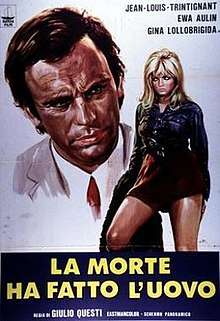Death Laid an Egg
Death Laid an Egg (Italian: La morte ha fatto l'uovo) is a 1968 giallo film directed by Giulio Questi. Written by Questi and Franco Arcalli, the film stars Ewa Aulin, Gina Lollobrigida and Jean-Louis Trintignant.
| Death Laid an Egg | |
|---|---|
 | |
| Directed by | Giulio Questi |
| Produced by | Franco Marras[1] |
| Written by |
|
| Starring | |
| Music by | Bruno Maderna[1] |
| Cinematography | Dario Di Palma[1] |
| Edited by | Franco Arcalli |
Release date |
|
Running time | 110 minutes[2] |
| Country | Italy France |
| Language | Italian |
Plot
Married couple Anna and Marco run a hi-tech automated poultry farm, breeding boneless chickens. Unbeknownst to Anna, Marco is a serial killer, who lures prostitutes to motel rooms before stabbing them. The arrival of Anna's cousin Gabri further fragments the troubled marriage, as she and Marco begin an affair and conspire to run away together. However, Gabri is actually plotting with her husband Mondaini to kill Anna and frame Marco, as they have discovered Marco's secret. When Marco discovers Anna's body in his hotel room, he cleans the crime scene and takes the body back to the farm to dispose of it. What Gabri and Mondaini do not know is that Marco's fixation is not with killing prostitutes, but simply hiring them to role-play murders, letting them go safely and handsomely paid. At the farm, Marco falls into a machine used to grind chicken feed in which he was trying to dispose of Anna's body. When the police arrive, having responded to the "murder" at the hotel and then coming to the farm to investigate Marco's alleged activities, the police focus their attention on Gabri, suspecting her of committing the murder out of sibling jealousy. Gabri and Mondaini are eventually arrested for Anna's murder, as the farm chickens feed on Marco's ground corpse.
Cast
- Gina Lollobrigida as Anna
- Jean-Louis Trintignant as Marco
- Ewa Aulin as Gabri
- Jean Sobieski as Mondaini
- Renato Romano as Luigi
- Giulio Donnini
- Vittorio Andre
- Cleofe Del Cile
- Monica Millesi
- Aldo Bonamano
- Ugo Arinolfi[3]
Production
Death Laid an Egg was directed by Giulio Questi, who co-wrote the screenplay with editor Franco Arcalli.[1] The pair had collaborated the previous year on the spaghetti western film Se sei vivo spara, in the same roles.[4]
Release
Death Laid an Egg was released in Italy on January 9, 1968.[5] The film has also been distributed internationally under the titles A Curious Way to Love, Death Laid an Egg, Death Trap and Plucked.[6] It was re-released in France as Le Sadique de la Chambre 24 (transl. The Sadist in Room 24.[3]
Reception
The Monthly Film Bulletin declared the film as "a genuine curiosity" with its "bizarre eroticism" concluding it was "not uninteresting, but unfortunately has the effect of giving some of the digressions rather more weight than the control narrative."[7]
Writing for AllMovie, Robert Firsching rated the film three stars out of five, and found it difficult to place in a genre, considering it a mix of giallo, science fiction and drug film elements. Firsching described the film as "deliriously strange", noting that it was "a must-see for genre fans"; he also stated parts of the film resemble David Lynch's Eraserhead.[5] Luis Canales, in his book Imperial Gina, reports that the film "received lukewarm criticism" upon release, although he writes that both Questi and Lollobrigida were pleased with it.[8] Gian Piero Brunetta, author of The History of Italian Cinema, considered the film to be "worth remembering", comparing it to the works of Luis Buñuel and Michelangelo Antonioni. Brunetta felt the film held several thematic undercurrents, dealing with the conditions of farm labourers and the changing social attitudes towards the class system in Italy.[9] In March 2015 the film was re-released as part of the Malastrana Film Series in the event The Killer Must Kill Again!: Giallo Fever, Part 2 as part in the Anthology Film Archives in New York City over Malastrana Film Series on 35mm.[10]
Footnotes
- "BFI | Film & TV Database | La morte ha fatto l'uovo | Full Credits". British Film Institute. Archived from the original on January 16, 2009. Retrieved October 29, 2012.
- Luther-Smith 1999, p. 32.
- Luther-Smith 1999, p. 33.
- "BFI | Film & TV Database | Se sei vivo spara | Full Credits". British Film Institute. Archived from the original on January 25, 2009. Retrieved October 29, 2012.
- Firsching, Robert. "La Morte Ha Fatto l'Uovo – Cast, Reviews, Summary and Awards". AllMovie. Archived from the original on 13 December 2012. Retrieved 15 September 2017.
- "BFI | Film & TV Database | La morte ha fatto l'uovo (1967)". British Film Institute. Archived from the original on January 14, 2009. Retrieved October 29, 2012.
- "Morte ha fatto l'uovo, La (A Curious Way to Love)". Monthly Film Bulletin. Vol. 36 no. 424. British Film Institute. May 1969. p. 105.
- Canales 1990, p. 175.
- Brunetta 2009, p. 203.
- NY! Argento, Bava and more 35mm “Giallo Fever” coming to Anthology Film Archives
References
- Brunetta, Gian Piero (2009). The History of Italian Cinema: A Guide to Italian Film from Its Origins to the Twenty-First Century. Princeton University Press. ISBN 0691119880.CS1 maint: ref=harv (link)
- Canales, Luis (1990). Imperial Gina: The Strictly Unauthorized Biography of Gina Lollobrigida. Brandon Books. ISBN 0828319324.CS1 maint: ref=harv (link)
- Luther-Smith, Adrian (1999). Blood and Black Lace: The Definitive Guide to Italian Sex and Horror Movies. Stray Cat Publishing Ltd. ISBN 0-9533261-1-X.CS1 maint: ref=harv (link)